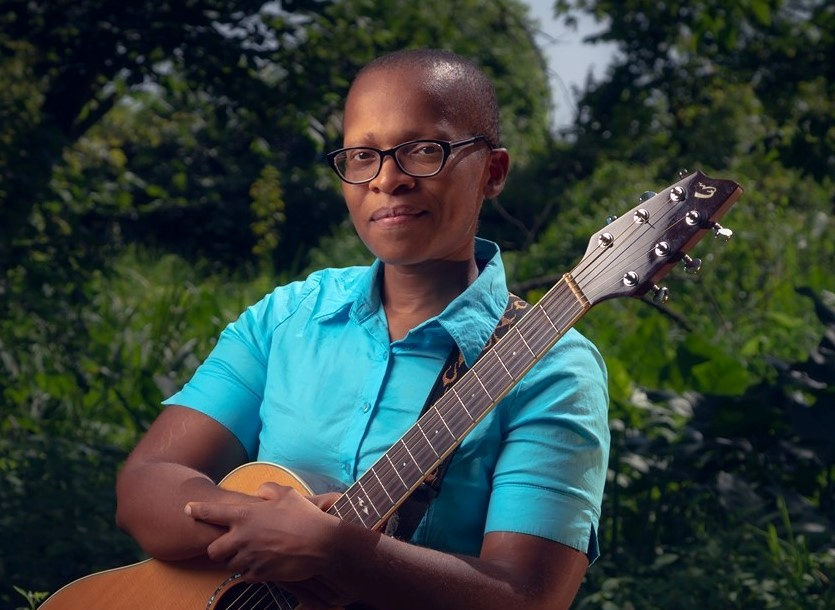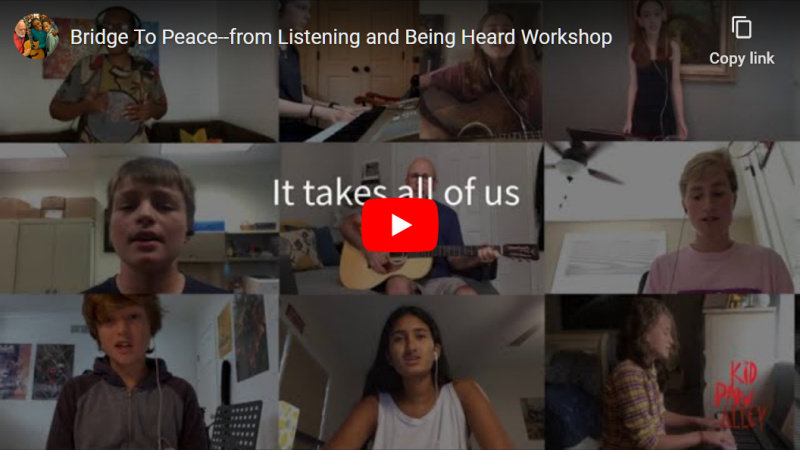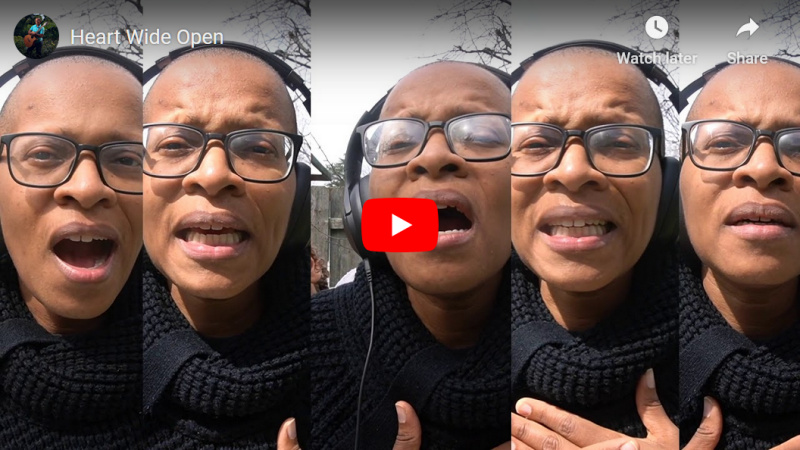For all the doors that the pandemic closes, it also opens the way to all manner of serendipity. In March, the Unitarian Universalist church I attend moved its services online, requiring worship leaders to get creative. Our music director shared a couple of videos made by Lea Morris, a singer/songwriter from the Washington, D.C., area—videos of Lea singing multi-part arrangements of her soulful, resonant melodies straight from her heart to the viewer’s. It turns out she also does music with young folks and has connections to CMN; some of her Kid Pan Alley collaborations circulated among the membership this summer. I couldn’t forget about Lea, and when I found out she is to participate in the 2020 CMN Annual (virtual) Conference, I knew had to learn and share more about her work.
Lea and I spoke via Zoom (how else?) about the ingenuity and creativity that arises in this time of restriction, about kids and their gifts, and the intertwining of music and spirituality. She was generous with her stories, insights, and humor, and it’s my pleasure to pass them on.
 Lea Morris
Lea MorrisGinger: I want to talk about the work you’ve been doing during the pandemic, but first let me ask: what were you doing before all this happened?
Lea: For the last twenty, twenty-five years I’ve identified as a singer-songwriter, playing acoustic guitar, and singing original songs and interpretations. I started about eight years ago to teach preschool music as well, interactive music experiences for kids. Then I started maybe five years ago to do music for spiritual gatherings: synagogues, churches—as long as their world view was similar enough to my own! That’s pretty much the scope of what I was doing. Obviously, the physical performances and teaching were then immediately no longer available from one day to the next, which was really an interesting experience: to suddenly have to redefine what you do as an artist.
How did you get into working with kids?
Well, I have kids—
I’ve seen them in your videos!
Yeah. So I was already making music with children at home, but I hadn’t really thought of it as something to do on a broader scale, until my mother-in-law mentioned it to me. And perhaps partly because of the source, I just kind of ignored the idea for three or four years. Then suddenly one day, I just thought, you know, my kids seem to enjoy this and I obviously enjoy making music with them—this could be something that’s mutually beneficial for me and more kids, so why not pursue? And as soon as I made that mental shift that “I’m ready to do this”, there were opportunities abounding.
What are some of the things you discovered working with kids after performing for adults?
Usually when I perform my original music, I close my eyes; that’s just a habit I’ve developed over the years, and that is NOT available when you’re playing with kids. There’s none of this going into yourself stuff; you’ve got to be in the moment, you’ve got to be present with them. There’s no checking your phone—nothing but that moment with them. And it’s a really great lesson. It’s a wonderful thing to practice.
Did that then change the way you performed for adults?
Not really. I actually think this time—this whole COVID sharing experience—might do that, because likewise, when I’m performing for the camera, I don’t close my eyes. I just feel like that’s too much of a barrier. There’s already enough between us that I need to be with whoever I’m sharing with. So that might change! I guess we’ll see.
I know you’ve done some work with Kid Pan Alley. Do you have any favorite experiences with them?
Recently we did a workshop for teens where we gathered with the group and discussed the current moment—socially, politically—and what we feel. And I should say it was really teen led; it was led by the students, and Robbie Schaefer and I facilitated the conversation and the songwriting process, but it was their thoughts and their ideas and ideals. Just thinking about where we are as a nation, and where we want to be, and what it’s going to take to get there.
So they wrote a beautiful, beautiful song called “Bridge to Peace.” That’s the most recent experience that was meaningful to me. On one occasion, I walked out of a residency and just felt completely certain that with the influence of my parents and my love of kids and my love of music and the way I communicate that I was really born for the work. You know that feeling, where you’re just like, “Ahh!” What is it that quote: “There are two important days, one is the day you were born and the other is when you figure out why.” It was one of those moments.
 “Bridge to Peace” from the Kid Pan Alley Listening and Being Heard Workshop
“Bridge to Peace” from the Kid Pan Alley Listening and Being Heard WorkshopWhat was it about that experience that was so meaningful?
I think it was a culmination of so many things I had learned up till that point. I was just able to bring so much of myself into the moment and to share meaningfully with those kids and then receive what they were sharing. I feel like I was enhanced leaving the experience and knowing that they were as well. Pretty good stuff.
What inspires you in your songwriting?
Oh, everything. Everything’s a song. My next-door neighbors have mint growing in a pot that’s accessible from the sidewalk, and every time I walk that way, I grab just a little, you know, take a leaf. I just take the scent. And one morning the scent turned into a song. The songs are everywhere.
Mmm, mint! I love it.
Let’s hear a little bit about your work with worship and spiritual communities. How did that come about?
I was raised in the Baptist tradition, so worship music is my foundational music. Using music or experiencing music to find and understand the divine as each of us defines it—that’s who I am. I’m able now to take that outside of just one tradition and recognize that the divine is what each of us defines it to be, and it’s always present in music. There’s always something common and universal in music. That’s my experience, and so everywhere the message resonates with how I see the world, I’ve been welcome and excited to be able to share.
Do you sing for people, or lead them in song or teach them songs, or both?
Definitely both. Even when I’m doing regular concerts for general audiences, I incorporate a lot of opportunity to sing along. At some point a few years ago, I realized I don’t just want to sing at people; I want to have musical experiences that also invite them to be part of the music.
And your songs seem perfect for that.
Thank you!
I was really struck, watching your videos, by you taking these multiple shots of yourself and blending them together. It was beautifully done. Could you talk a little bit about how you started doing that?
Yeah, it’s so hilarious. I mean, probably you won’t laugh, but it’s funny the way it came about. It was pretty much the same time that I came to terms with the fact that I wasn’t going to be giving concerts and teaching and all these other things—I had this whole outline of what the year was going to look like and probably everybody did—and so I had my grieving process over that. I tend to take a walk every morning, and one of the mornings shortly thereafter I started singing something and hearing different harmonies and ideas for it, which is not usually how I had performed up to that point. I did a lot of a cappella harmonies when I was a kid but hadn’t done that in decades. And it was just there, and I had GarageBand on my phone, so I just recorded all the layers. When I got home I thought, “Okay well, I can’t do my concerts, but maybe I can present this somehow.” I had to figure out the tech of how to do that, and that took a couple of days but once I did it I was like, “Oh, okay. So this is what I’m doing right now. Cool!”
Were you adept with the technology already or was it a learning experience?
It was totally a learning experience. In January of this year, I decided I would do a webcast, which required me to learn Adobe Premiere Pro. So I had the software and I had opened it and I had played with it, but I hadn’t done anything like this with it before. For me it was just this huge “Aha! You can still share, you can still create, you’re not shut in. You’re fine; just go forward and do your thing.”
What was the first one you did?
I think it was “Heart Wide Open.” I did it in my backyard, and I asked my four-year-old to give me ten minutes, and she was like, “Sure, Mommy, I can play in the sandbox!” And then she jumped on my back in the final take. And I was like, I could either put her back in the sandbox or keep it, and I decided to keep it because for me it was part of the lesson: this is my reality now. It’s all good.
 “Heart Wide Open”
“Heart Wide Open”How did that spread around? It seems to have taken on a life of its own, since it’s showing up in worship services here in Massachusetts!
I put it on YouTube—that was it, initially. Then, a friend of mine who is affiliated with UU music asked if I would make that and other recordings available to folks, and I said “Of course! That’s why it’s here.” And then that just opened up relationships. There are quite a few congregations who are sending donations; there are those who have inspired me to start a song archive so that they can download rather than stream; and I’m sure there are groups that are just using it, pro bono, and it’s all good! It’s all good. I consider myself prosperous in many ways.
Have any interesting connections or collaborations popped up from that?
I’ve got a new friend in New Zealand, which is fun. And that whole thing of doing Zoom song circles is really weird and new and wonderful, too. There are these communities—they’re not really choirs, because the idea is not to perfect music for performance purposes so much as the togetherness and the connection. So now they’re doing that on Zoom, and it’s new to me, new and really delightful, even though Zoom is not the same as being in person. It’s still this ongoing connection.
I did see one of your videos with the big group of people singing. How did you find them? Was it an established song circle?
For that specific video, I sent out kind of an APB on my Facebook and a couple of friends who are song leaders forwarded it to their email lists. Whoever responded had to do a little work—they had to record themselves—but once they sent me the videos I was able to put them together in the software.
So now you’re an expert at this…
More and more. I’ve started taking some online tutorials. It’s a lot of fun, and you know, the subject is bottomless.
. . . and I believe, teaching it?
(chuckles) Yeah, that too. You know why? I’ve gotten so many emails: “How do you do that?” And I figure, rather than trying to tell everyone individually, I made a tutorial and put that on YouTube within the first month. If a person would like to, and has the software and a bit of savvy, they could definitely figure out how to do it, but I also understand that for some folks it’s more comfortable to have an organized class and someone you can ask questions. I can definitely tell you what I know!
You made the wonderful “Wake Up in America” video with 123 Andrés, who has done a lot with CMN, and the song was co-written by member Dave Kinnoin. I was wondering how that came about.
So that is one of my favorite songs in the universe. Andrés gave me the Grin Brigade CD of Dave’s a few years ago, and I was listening to it with my kids, and when that song came on I just burst into tears, it moved me so deeply. So I learned it and I started playing it everywhere; every chance I got, I played it. In the aftermath of George Floyd’s death, there were some songs and some messages that were being shared, and that was the one that resonated with me. That is what I wanted to sing. And I felt that it would be most meaningful if it wasn’t just me singing it, if I could find kind of a Rainbow Coalition of Americans to play and sing it with me. So those guys stepped up.
 “Wake Up in America”
“Wake Up in America”Has George Floyd’s death and the protests and the national conversation about it had any other influence on your work?
I think as an artist, if you’re at all aware of what’s going on, then it’s going to influence you. Unless you’re under a rock, everything’s going to influence you. I have been very intentional, and will continue to be intentional, about creating songs that are . . . beautiful—that feel beautiful and that feel joyful and that feel empowering. That’s just my choice. I feel like anything anybody feels led to sing in response, or say in response, to this time, whether it’s the pandemic or the changing of the nation, or the political situation, whatever it is, it’s all valid. What I feel called to sing are those songs, those messages.
How do you practice self-care?
I feel really fortunate to have a practice that existed before this time, so it’s not like scrambling and “Aaaaahh! Everything’s weird! Now what?!” It’s more about being consistent, and the practice is—there is a meditation aspect and introspection and all sorts of things, but it’s ongoing. One of the reasons I admire practitioners of Islam so much is that they see it as a way of life—it’s not just something I do on Sunday, this is who I am. I definitely see my spiritual—and that’s probably too esoteric a word for it—my practice as who I am. And I don’t want to be disparaging to anyone else. In the tradition I was raised in, there was the Sunday service, and then we were there, like, four times a week, and there was Bible study, and there were a lot of other things. But there was a lot of duality about it; let’s put it that way. So I learned from that that is not how I choose to practice.
With your own kids at home and maybe with the kids you’ve worked with during this time, have you found resources for reaching kids in what is a really tough time for everybody?
You know, I’ve always wanted to home school and I’ve been fascinated by unschooling, so it was an opportunity to kind of do that. How amazing is it that I can literally find a German teacher online, my son can look at anything he wants to know about history, or we can take drawing tutorials—whatever it is, if you’re interested, the information’s available. It’s just remarkable.
Anything else you want to say about music and kids?
This morning, Jacob [age 11] and I were watching Lucy [age 4] play: she jumped into a laundry hamper, decided it was a boat, and started rowing across the living room. It’s probably true that she’s even more creative now than when we had so much to do and we had so many places to go. And so, while this time is challenging and it’s weird and it’s new and different, it also does offer us possibilities for creativity and imagination. Especially people who work with kids, keep that in mind. Keeping that alive and staying fresh and in the moment is still available, maybe even more available than when we were in such a rush to get to all of our teaching gigs!
Also, I’m planning on creating a children’s songbook. I just put a general songbook out and now got all these kids’ songs. I know what the process is so I’m going to do that!
Wonderful. Good luck with that, and with everything you’re doing. Looking forward to seeing you virtually in October!
Yes indeed, if not before. Thank you!